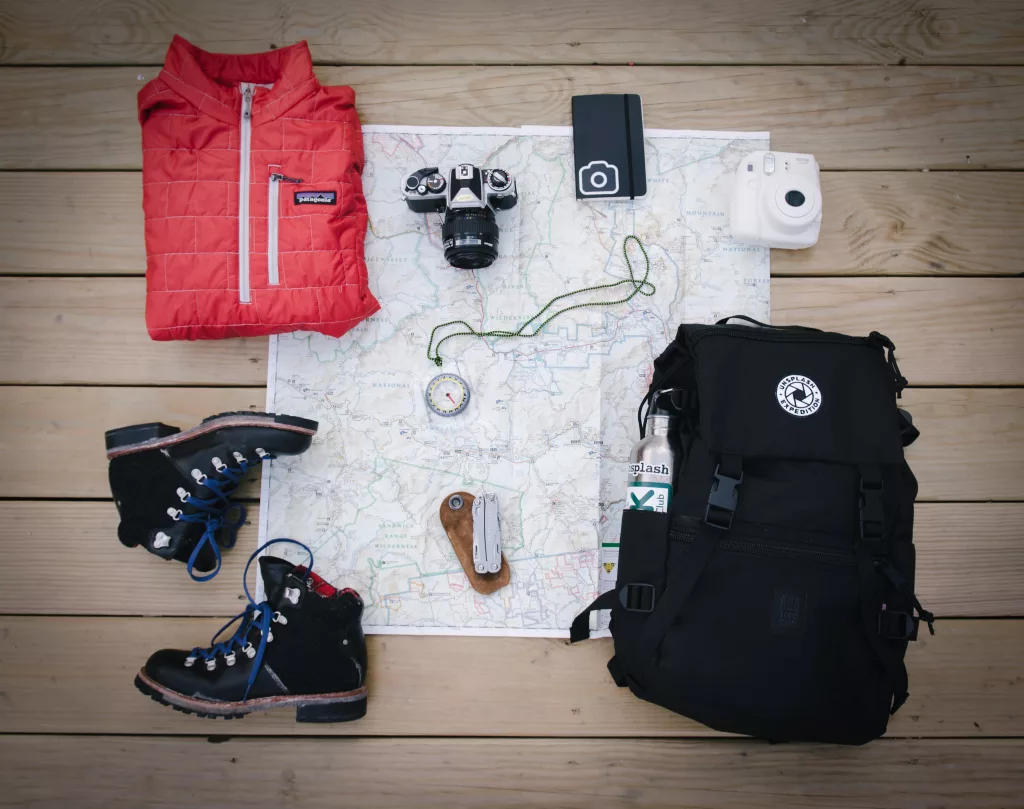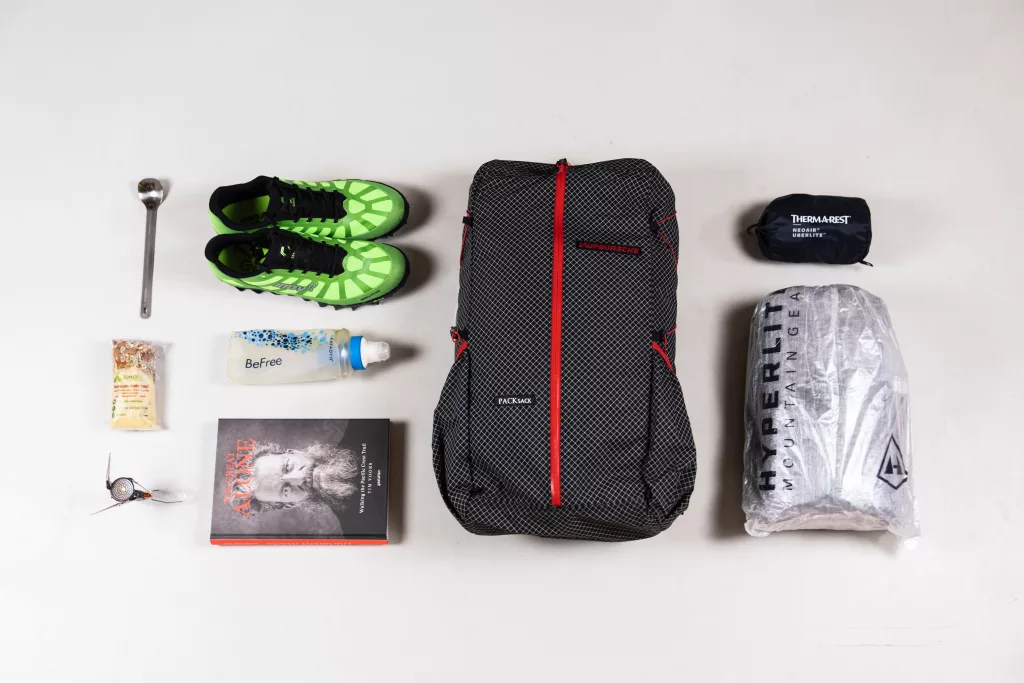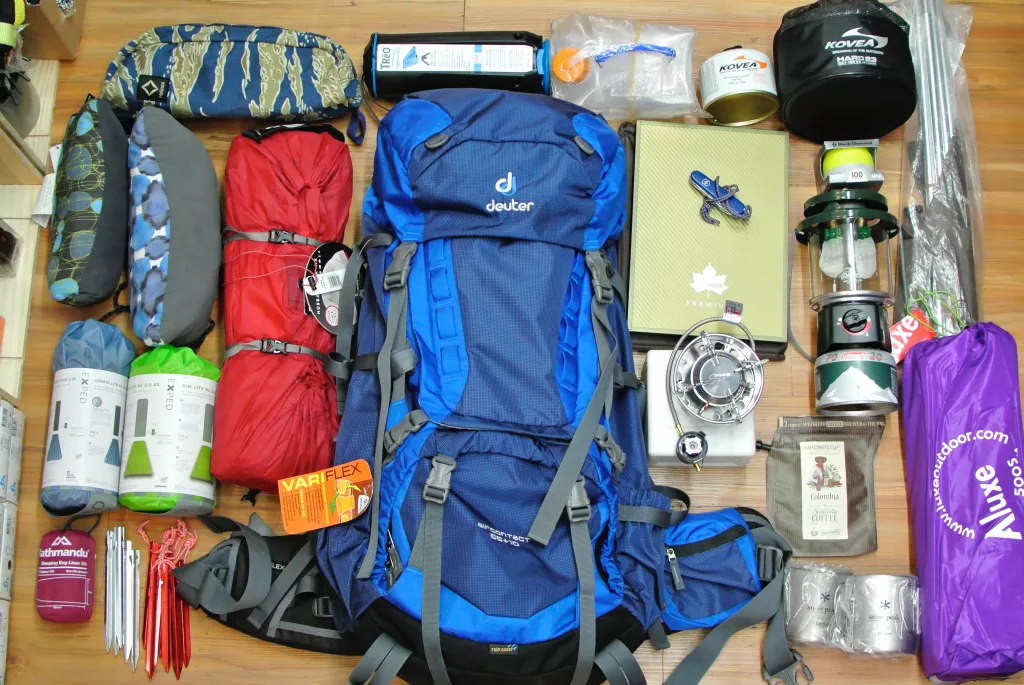The Important Job of a Hiking Kit for Survival:
Imagine this: You are far in a beautiful forest, the sun goes down under the sky and suddenly the cold air grabs you. Your carefully planned trip has now gone to a surprising place. Now, imagine you open your backpack and take out a small, ready-to-use survival kit. A blanket that keeps you warm in emergencies, a light that always works and a kit to treat small injuries – these common things can change what could be risky into something easy.
Spotting Potential Dangers in the Forest
The wilderness, with all its amazing variety, also gives a special kind of problems. It’s important to know about the dangers like bad weather, hard ground and meeting animals. There is always a chance of getting lost too. This understanding is what you need to make your survival kit, making sure you’re ready for anything.

Setting the Stage for Adventure: Basic Hiking Essentials vs. Comprehensive Survival Kits
Everyone who loves hiking needs some basic things – a strong backpack, comfy shoes, clothes for any kind of weather, tools for finding the way and lots of water and food. These are not up for discussion, the base of any fun walk. But we should not mix important things with everything you need to survive. The second one is more than just the basics, providing an additional level of readiness for unexpected situations. Think of it as a safety net for your calm, letting you go on adventures without worry and handle problems with a feeling of power.
Assessing Your Hiking Environment
Now that we’ve established the importance of a well-stocked survival kit, let’s dive into the heart of the matter: Make your hiking set match to the place where you are going.
Making Your Kit Different Based on Ground and Path Challenge Level.
A slow walk in a bright field needs different stuff than climbing up a snowy mountain. The kind of land you pick – like flat, hill, mountain or beach areas – tells what tools you need. A strong walking stick may be needed to deal with rough grounds, while things called crampons and an ice axe become very important for going over icy hills. Also, the level of difficulty on the path affects what you carry. A long and far-away hike needs a big survival kit that makes you independent for many days.
Thinking About Changes in Season and Weather Situations
Mother Nature is a tricky goddess, and outside weather can switch suddenly like the snap of a finger. Getting ready for a hot summer hike is very different from preparing for a cold winter trip. Remember the changing seasons of your trail and bring what you need. It’s important to use sun lotion, bug spray and a ventilated hat when going for walks in summer. In winter though we need a raincoat that doesn’t let water through, layers of clothes to keep warm and special shoes for traction on the ice or snow. Always look at the weather report before you start and be ready for any quick shifts.
Checking for Possible Dangers in Your Selected Hiking Spot
Each hiking spot has its own special set of dangers. Look up the place you want to study and find out what risks might be there. Can there be sudden floods? Are there places where avalanches can happen? Does the area have many wild animals? Knowing these dangers lets you pack the right way. For example, if there’s a worry about flash floods you should bring a waterproof dry bag and whistle to ask for help. If you might meet bears, think about bringing bear spray and learning the right ways to handle it.

Navigation Tools for Wilderness Exploration: Finding Your Way with Confidence
Being lost in the wilderness can make a fun adventure turn into a scary dream. That’s why tools for finding your way are very important when you want to explore nature. These helpful friends help you travel in unknown areas, always making sure you know how to get back. They also give you the feeling of being confident and allow you to really enjoy nature’s beauty.
Detailed Topographic Maps:
Throw away those weak tourist maps – when going into the wild, buy a detailed mountain map. These maps, like the example of a map showing Mount Rainier’s mountains. They are carefully made to show how land is shaped. The maps also show paths and roads as well as changes in height, points of interest and water sources. Learning to read these maps lets you know a secret language of the land. It makes it easier for you to move around on your own and make good choices.
Reliable Compass for Directional Guidance:
Sometimes, even with the best map, you need a little more help. That’s when the compass is useful. This old fashioned thing, like the classic Silva compass, gives a constant guide. It makes sure you keep moving in the right direction no matter where you are or what weather happens. Learn how to use a compass properly and you’ll be able to figure out where you are, follow directions, and return home like a pro traveler.
Modern GPS Devices for Precision in Hiking:
GPS devices like the Garmin in Reach Explorer give another level of safety with technology. These easy-to-use tools can show where you are right now. You can share your spot with family and even send distress messages if something bad happens. While GPS devices are not a good substitute for normal navigation skills, they can be very helpful. They are especially useful during long hikes or when you’re in remote places that can be hard to see.

Water Purification and Hydration Solutions:
Drinking water is very important when you go outside, but having clean water in the wild can be hard. So, cleaning water and ways to stay hydrated are really important parts of a good survival kit. These good friends make sure you always have fresh and safe water to drink. This keeps your energy levels up so you can face any problems easily.
Collapsible Water Containers for Easy Storage:
It is important to always have water handy while hiking. Buy foldable water bottles such as the Platypus Gravity Works hydration system. These space-savers get bigger when they are filled up. They let you carry lots of water without making your backpack heavier than it needs to be. Extra points for picking containers with filters already included, making your water cleaning process easier.
Hydration Bladders for On-the-Go Drinking:
Drinking water often is needed when going through tough areas. Water bags like the CamelBak Eddy+ Reservoir are very easy to use. Kept safely in your backpack, they give you water through a tube right to your mouth. This means you don’t have to stop and take off the bag every time for a drink. This one you don’t have to hold, so it lets you concentrate on the road and helps keep your body from getting thirsty without much work.
Emergency Food and Nutritional Supplies: Fueling Your Wild Explorations
The fun of hiking often comes from testing yourself, trying to walk on new paths and climb unknown mountains. But making your limits also means seeing that your body stays filled up for the trip. That’s when emergency food and nutrition supplies come in. They give important nourishment if any sudden waits or energy needs happen.
Non-Perishable Snacks and Energy Bars:
Put some snacks and energy bars in your bag that will not go bad. Choose from things like Clif Bars or KIND bars. These high-energy snacks give you a fast boost of power when you need it most, helping to keep going through tough parts of the trail. Pick bars that have different mixes of protein, carbs and good fats to make sure you keep going with energy during your walk.
Lightweight Cookware Sets for Meal Preparation:
For big walks or long journeys, bring a light cookware set like the GSI Infinity Mug. This useful thing lets you make warm food and drinks, making you feel better. It also gives your body the important nourishment it needs to work best. Remember, making hot food not only warms you up but also makes your feelings feel better. So, it’s a good thing to have when making food in the wild areas.
Nutrient-Dense Options for Sustained Energy:
Instead of just fast foods, try to add healthier options like nuts and dried fruits with a lot of vitamins. They provide you with essential vitamins, minerals and lasting energy. They assist in making you feel good when out hiking. Consider adding lots of protein foods like jerky or tuna pouches to help your muscles heal better. This is very important after hard parts of your journey.
Conclusion:
Now that you have seen the main parts of a full hiking survival kit, you can go on trails with confidence. Remember, preparation is key. Create your kit only for where you are and what might happen. This changes a group of things into something powerful that helps you stay strong and calm.
Here are some final takeaways to keep in mind:
• Always look at your things before you leave. Make sure your water cleaner is good, check if your special health kit has all items needed and try the power in your light on head.
• Respect the wilderness. Don’t make any mess and always remember to take care of nature.
• Don’t hike alone, especially if you are new to the trails. Share your plan with someone and stick to it.
FAQs: Your Questions Answered
What’s the difference amongst a simple trekking package and a complete survival package?
A simple trekking package includes the requirements you want for a snug and safe hike, inclusive of a backpack, water, meals, navigation tools, and weather-appropriate apparel. A whole survival package deal goes past the fundamentals, offering additional gadget for surprising conditions, like first-useful resource resources, emergency shelters, fireplace starters, and signaling devices.
How a whole lot weight ought to my survival kit be?
Ideally, your survival kit need to be light-weight and compact enough to carry simply for your backpack without including extensive weight. Aim for a package that weighs no more than 10% of your total % weight.
What are some common errors to keep away from whilst constructing a survival kit?
• Overpacking: Only percent what you need and keep away from bulky items.
• Underpacking: Make positive you’ve got sufficient substances all through your hike and potential emergencies.
• Not checking out your gear: Ensure the whole thing on your kit is in desirable working order earlier than heading out.
• Not tailoring your kit to your environment: Consider the terrain, climate, and potential dangers of your selected trail.
I’m new to hiking. Where can I learn extra approximately survival capabilities?
There are many assets to be had to study survival capabilities, along with on line tutorials, books, and out of doors shops. Consider taking a barren region survival direction or joining a hiking membership to benefit realistic information and learn from skilled hikers.
